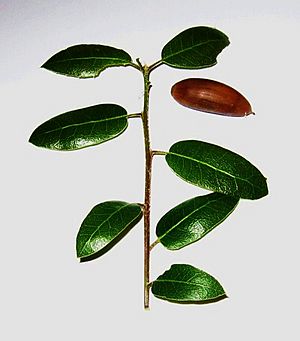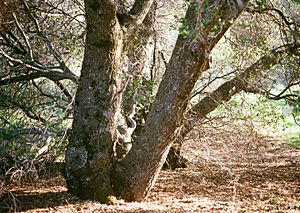Interior live oak facts for kids
Quick facts for kids Interior live oak |
|
|---|---|
 |
|
| Leaves and acorn. The leaf margins are sometimes spiny rather than smooth. | |
 |
|
| Typical growth habit | |
| Conservation status | |
| Scientific classification | |
| Genus: |
Quercus
|
| Species: |
wislizeni
|
 |
|
| Combined ranges of Quercus wislizeni and Quercus parvula | |
| Synonyms | |
|
|
The interior live oak (scientific name: Quercus wislizeni) is a type of oak tree. It stays green all year round, which is why it's called an "evergreen" tree. You can find it in many parts of California in the United States. It also grows south into northern Baja California in Mexico.
This tree often grows in foothills, which are the low hills at the base of mountains. It's very common in the lower parts of the Sierra Nevada mountains. It also grows in the Pacific Coast Ranges and the San Gabriel Mountains. The tree was named after Friedrich Adolph Wislizenus, who collected it.
Contents
What the Interior Live Oak Looks Like
The interior live oak can be a large shrub or a tree. It can grow up to about 22 meters (72 feet) tall. However, in the Sierra foothills, it's usually shorter, often less than 10 meters (33 feet) tall.
Its leaves are dark green and can look a bit grayish from far away. They are usually small, about 2 to 5 centimeters (0.8 to 2 inches) long. The leaves are thick and sometimes have spiny (pointy) edges, especially on younger trees or in higher places.
Flowers and Acorns
The male flowers of the interior live oak grow in long, hanging clusters called catkins. The female flowers are smaller and grow where the leaves meet the stem.
The acorns are the seeds of the oak tree. They are about 1 to 2 centimeters (0.4 to 0.8 inches) long. It takes a long time for the acorns to grow and be ready. They mature about 18 months after the tree flowers.
How the Interior Live Oak Got Its Name
Plants often have scientific names that help scientists around the world know exactly which plant they are talking about. The interior live oak's scientific name is Quercus wislizeni.
This name was first published by a scientist named Alphonse Pyramus de Candolle in 1864. He named it after Friedrich Adolph Wislizenus, who collected the plant. At first, people thought the plant was found in Chihuahua, Mexico. But later, another botanist, Georg Engelmann, found out it was actually collected near Auburn, California.
Sometimes, there can be different ideas about the best scientific name for a plant. Another scientist, Albert Kellogg, described a similar oak in 1855, calling it Quercus arcoglandis. Scientists are still looking into whether this is the same tree. If it is, Kellogg's name would be older and might be used instead.
Ecology and Hybrids
The interior live oak is part of a group called "red oaks." These oaks are found in the California Floristic Province.
Sometimes, different types of oaks can "mix" or "cross-breed" with each other. This is called hybridization. The interior live oak can hybridize with the California black oak (Quercus kelloggii). When they mix, they create a new type of oak called Quercus × morehus, also known as Abram's oak. Many red oaks in California show signs of this mixing.
The interior live oak often grows near another tree called the gray pine (Pinus sabiniana).
Uses of the Interior Live Oak
Animals like deer eat the leaves of the interior live oak. People sometimes use the wood from these trees as a source of fuel, like for fires.
Images for kids
See also
 In Spanish: Quercus wislizeni para niños
In Spanish: Quercus wislizeni para niños




